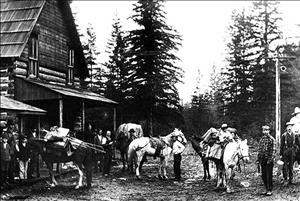On May 27, 1910, the United States Lumber Company files a complaint asking for a restraining order to halt a planned election to incorporate the town of Darrington, located in Snohomish County. The pro-election group wants the town to incorporate so it can exercise a local option to retain its saloons. The lumber company along with several leading citizens opposes the incorporation election and supports a dry town. W. R. White, secretary and treasurer of the lumber company, is named spokesman for the plaintiffs (opposing the election). Over the next few days, their lawyers present evidence that a petition for the election approved by Snohomish County Commissioners is invalid. The verdict ensures that Darrington will stay unincorporated and will go dry.
Wet vs. Dry
The town of Darrington was settled around 1890 by settlers and miners drawn to the rich minerals in the rugged mountains close by. By 1906, it had a population of 100 and several saloons, saw mills, hotels, groceries, and hardware store.
"Local option" is a general term for laws that allow voters to decide if or how alcohol will be sold in their communities. In 1909, the pressure for prohibition of alcohol was high in Washington state and drafting a statewide local-option law was a step towards it. The state legislature passed the law in 1910. Counties immediately arranged for elections.
When Snohomish County announced that a local option election would be held there on July 5, 1910, "wets" in Darrington, who wanted to keep their local saloons and expected, correctly, that Snohomish County voters would support prohibition, filed a petition with the county commissioners asking to incorporate Darrington as a fourth-class town, which would not be bound by the county vote. They hoped, by incorporating, Darrington would stay "wet."
The petition was filed on May 15, 1910. Commissioners James McCulloch and A. L. Willhite approved an election for June 2, 1910. Immediately, the United States Lumber Company, the town's largest employer, and several members of the town's founding pioneers, filed suit to stop the election.
On May 16th, the day after the Snohomish County Commissioners approved the date for the election on incorporating Darrington, they received a complaint stating they had overlooked the plaintiffs' concern that the signers asking for incorporation were not qualified voters. The commissioners "also failed and refused to take any steps for the purpose of ascertaining whether or not said district contained three hundred inhabitants or any other number, but arbitrarily based said order merely upon the false, fraudulent and unlawful oral statements of certain of said petitioners." (Complaint, Snohomish Superior Court Case #10603). The proposed election was also a "large expense to the plaintiffs and other taxpayers within limits of said district."
Playing with Numbers
Speaking for the plaintiffs, which included pioneers Nels, Knute, and Ole Neste and Charles Burns, W. R. White, Secretary and Treasurer of the U.S. Lumber Company laid out their case. First, the sole purpose of incorporating Darrington was to make it a wet town under the Local Option Law. To secure this goal, the defendants had misrepresented the number of qualified voters petitioning the commissioners for the vote on incorporation. The defendants had defined the proposed boundaries of the town, but 23 of the 67 signers were not residents or voters in "said district." The number of residents within the town had also been inflated. Contrary to information in the petition, Darrington did not have 350 residents. The 20- to 40-acre tracts included in the boundaries were totally uninhabited, containing "nothing but timber suitable for milling and manufacturing purposes" (Complaint).
White proceeded to question some of the names on the list:
-
William Hamilton Canadian
-
J. W. Barner Never knew him
-
J. T. Watson Never heard of him
-
John Heim Remonstrator
-
A. J. Peterson Remonstrator
-
W. J. Snyder Remonstrator
A summons to appear was issued by the court, giving the plaintiffs time to do a quick tally of the legal residents in Darrington. On May 28, Gus Neste took census of every man, woman, and child "residing in, and belonging to the proprietors of several hotels, stores, saloons, and Northern Pacific." His handwritten list was typed and run off on carbon copies for presentation to the courts. His count revealed that there were only 234 residents. (Exhibit C, Snohomish Court Case File No. 10603 ).
As result, at 11 a.m. on May 31, 1910, a restraining order for the election on incorporation was issued. Final cost was $81.60 for witness fees and day trip to Everett for the court hearing.
Darrington Goes Dry
The U.S. Lumber Company and other plaintiffs successfully stopped the June 2, 1910, election for incorporating Darrington. On July 5, 1910, a election was held throughout Snohomish County for the purpose of submitting to a vote the question of putting into force the Local Option Law.
As a result, the county went dry, except in incorporated areas that made their own choices. Darrington went dry with the rest of the county, and the town stayed unincorporated until 1945.

